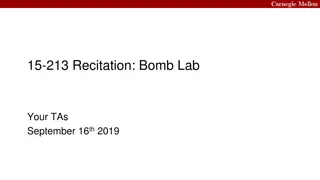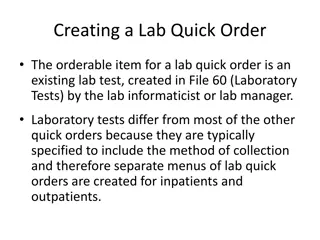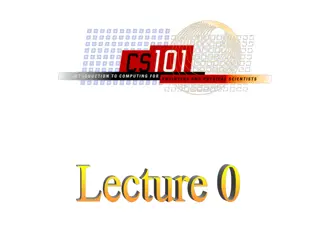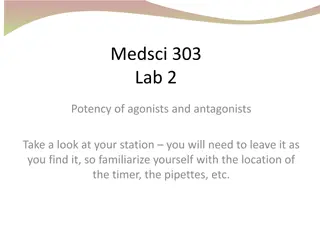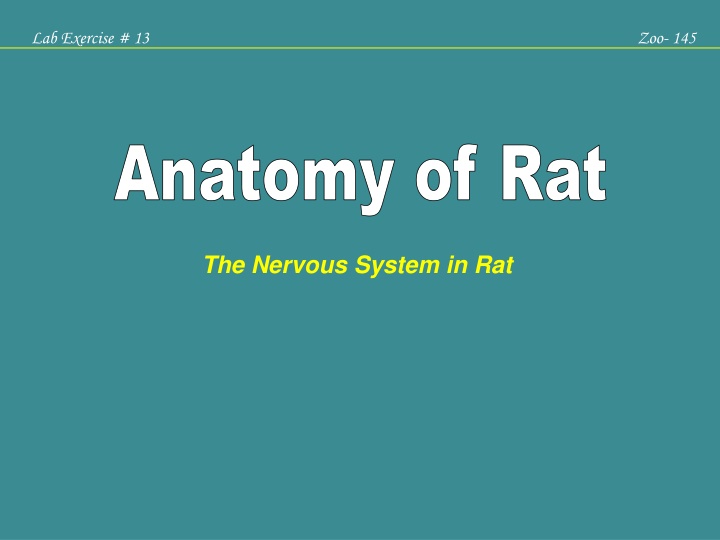
Anatomy of Rat Nervous System: CNS, PNS, Brain, Spinal Cord
Explore the detailed anatomy of a rat's nervous system, divided into the central nervous system (CNS) and peripheral nervous system (PNS). Learn about the components such as the brain, spinal cord, cranial nerves, and spinal nerves. Discover the functions of the CNS and PNS in maintaining homeostasis and transmitting nerve impulses. Dive into the structure and roles of the cerebrum, frontal lobe, olfactory bulbs, and more.
Download Presentation

Please find below an Image/Link to download the presentation.
The content on the website is provided AS IS for your information and personal use only. It may not be sold, licensed, or shared on other websites without obtaining consent from the author. If you encounter any issues during the download, it is possible that the publisher has removed the file from their server.
You are allowed to download the files provided on this website for personal or commercial use, subject to the condition that they are used lawfully. All files are the property of their respective owners.
The content on the website is provided AS IS for your information and personal use only. It may not be sold, licensed, or shared on other websites without obtaining consent from the author.
E N D
Presentation Transcript
Lab Exercise # 13 Zoo- 145 Anatomy of Rat The Nervous System in Rat
Nervous System The nervous system in rats is divided into two parts: 1. The central nervous system (CNS) 2. The peripheral nervous system (PNS) The central nervous system consist of Brain and Spinal Cord, The peripheral nervous system is composed of all nerves outside the central system (Spinal nerves and cranial nerves) The rat have 34 pairs of spinal nerves: 8 cervical, 13 thoracic, 6 lumber, 4 sacral and 3 caudal spinal nerve There are 12 pairs of Cranial nerves emerging from various parts of the brain The brain consist of three parts: The fore brain The mid brain The hind brain
Two parts of nervous sytem central and peripheral Central nervous system CNS consists of brain and spinal cord, serves as information input and output control center for the body, integrates regulates and controls bodys activities and relays impulses between brain and peripheral nerves Peripheral nervous system PNS composed of neurons arranged in nerves, contains sensory and motor neutrons that transport impulses to and from CNS Autonomic nervous system contains neurons that parallel PNS neurons with nerves, convey involuntary information such as breathing, heart rate, digestion, salivation, perspiration to and from CNS Homeostasis maintain body in stable condition, purpose of nervous system, accomplished by generation of nerve pulses that travel along nerve conduction pathaways Receptors impulses originate from these specialized sensory structures
Eendocrine system releases signaling molecules called hormones into bloodstream ex. pancreas secretes insulin testes secretes testosterone Cerebrum anterior larger upper part of brain, associated with higher brain function such as thought and action, divided by longitutional fissure Longitudional fissure divides cerebrum into the right hemisphere controlling left body and vice versa Frontal lobe apart of cerebral cortex, associated with reasoning, planning, speech, movement, emotions, problem solving Olfactory bulbs recieve sensory neurons from nasal cavity and are responsible for smell Cerebellum posterior and slightly underneath cerebrum, primary reflex center for skeletal movements, coordination and balance Medulla oblongata brain stem leading to spinal cord, located at base of cerebellum, regulates heart beat breathing sweating vomiting and digestion








